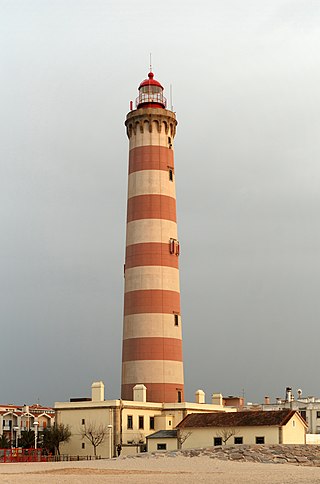
A lighthouse is a tower, building, or other type of physical structure designed to emit light from a system of lamps and lenses and to serve as a beacon for navigational aid, for maritime pilots at sea or on inland waterways.

A lightvessel, or lightship, is a ship that acts as a lighthouse. They are used in waters that are too deep or otherwise unsuitable for lighthouse construction. Although some records exist of fire beacons being placed on ships in Roman times, the first modern lightvessel was off the Nore sandbank at the mouth of the River Thames in England, placed there by its inventor Robert Hamblin in 1734. The type has become largely obsolete; lighthouses replaced some stations as the construction techniques for lighthouses advanced, while large, automated buoys replaced others.

A buoy is a floating device that can have many purposes. It can be anchored (stationary) or allowed to drift with ocean currents.

The history of the many lightvessel stations of Great Britain goes back over 250 years to the placement of the world's first lightship at the Nore in the early 18th century.

Hawker Siddeley was a group of British manufacturing companies engaged in aircraft production. Hawker Siddeley combined the legacies of several British aircraft manufacturers, emerging through a series of mergers and acquisitions as one of only two such major British companies in the 1960s. In 1977, Hawker Siddeley became a founding component of the nationalised British Aerospace (BAe). Hawker Siddeley also operated in other industrial markets, such as locomotive building and diesel engine manufacture. The company was once a constituent of the FTSE 100 Index.
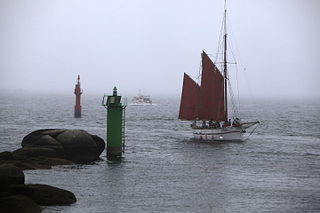
A sea mark, also seamark and navigation mark, is a form of aid to navigation and pilotage that identifies the approximate position of a maritime channel, hazard, or administrative area to allow boats, ships, and seaplanes to navigate safely.

The United States Lighthouse Service, also known as the Bureau of Lighthouses, was the agency of the United States Government and the general lighthouse authority for the United States from the time of its creation in 1910 as the successor of the United States Lighthouse Board until 1939 when it was merged into the United States Coast Guard. It was responsible for the upkeep and maintenance of all lighthouses and lightvessels in the United States.
The Commissioners of Irish Lights, often shortened to Irish Lights or CIL, is the body that serves as the general lighthouse authority for Northern Ireland and the Republic of Ireland and their adjacent seas and islands. As the lighthouse authority for the island of Ireland it oversees the coastal lights and navigation marks provided by the local lighthouse authorities, the county councils and port authorities.

The USCGC Conifer was a 180 foot seagoing buoy tender. Conifer and her sister ships, commonly referred to as "one-eighties", served as the backbone of the Coast Guard's Aids to Navigation fleet for over 50 years before their replacement by the newer Juniper-class cutters.
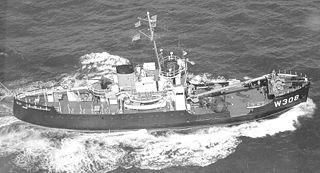
USCGC Papaw (WLB-308) was a sea-going buoy tender whose design is based on the pre-World War II United States Lighthouse Service Tenders. The original design was modified to provide an armored cutter capable of wartime missions in addition to her primary mission of Aids to Navigation. Papaw was built in 1943 by the Marine Iron and Shipbuilding Company of Duluth, Minnesota. Commissioned 12 October 1943, she was assigned the home port of San Francisco, California.
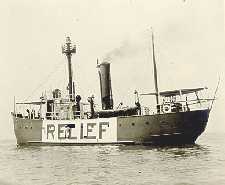
The United States lightship Huron (LV-103) is a lightvessel that was launched in 1920. She is now a museum ship moored in Pine Grove Park, Port Huron, St. Clair County, Michigan.

Sevenstones Lightship is a lightvessel station off the Seven Stones Reef which is nearly 15 miles (24 km) to the west-north-west (WNW) of Land's End, Cornwall, and 7 miles (11 km) east-north-east (ENE) of the Isles of Scilly. The reef has been a navigational hazard to shipping for centuries with seventy-one named wrecks and an estimated two hundred shipwrecks overall, the most infamous being the oil tanker Torrey Canyon on 18 March 1967. The rocks are only exposed at half tide. Since it was not feasible to build a lighthouse, a lightvessel was provided by Trinity House. The first was moored near the reef on 20 August 1841 and exhibited its first light on 1 September 1841. She is permanently anchored in 40 fathoms (73 m) and is 2.5 miles (4.0 km) north-east (NE) of the reef. Since 1987, the Sevenstones Lightship has been automated and unmanned.

A Texas Tower lighthouse is a structure which is similar to an off-shore oil platform. Seven of these structures were built in the 1960s off the shores of the United States. Automation started in the late 1970s, which led to the obsolescence of the housing built for the keepers which resulted in such a large structure. Three of the towers were dismantled over time due to deteriorating structural conditions among other problems, while another one was destroyed in a ship collision. The last Texas Tower was deactivated in 2016 having served for over half a century. Today only three of the former lights remain.

Carl Friedrich Julius Pintsch was a German tinsmith, manufacturer and inventor who is primarily known for the invention of Pintsch gas. The gas, distilled from naphtha or other petroleum products, was widely used in railway transport and marine navigation applications from its invention in 1851 until the 1930s.
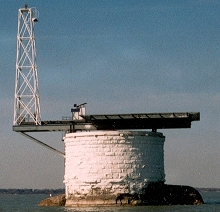
The Colchester Reef Light is an active lighthouse situated on Colchester Reef in the Western Basin of Lake Erie south of the town of Colchester, Ontario.

The Lightship Museum in the harbour of Esbjerg in southern Denmark consists of a private museum open to the public on board the Horns Rev lightship. Dating from 1912, the Horns Rev, also known as Motorfyrskibet Nr. I, is the world's oldest and best preserved motor lightship. It houses a highly regarded exhibition of life and work on board.
















